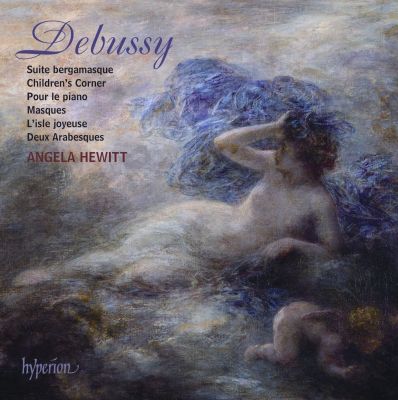Debussy_Solo Piano Music
The Canadian pianist’s first Debussy on disc
View record and artist detailsRecord and Artist Details
Composer or Director: Claude Debussy
Label: Carducci Classics
Magazine Review Date: 11/2012
Mastering:
Stereo
DDD
Catalogue Number: CDA67898

Tracks:
| Composition | Artist Credit |
|---|---|
| Children's Corner |
Claude Debussy, Composer
Angela Hewitt, Musician, Piano Claude Debussy, Composer |
| Suite bergamasque |
Claude Debussy, Composer
Angela Hewitt, Musician, Piano Claude Debussy, Composer |
| Tarantelle styrienne |
Claude Debussy, Composer
Angela Hewitt, Musician, Piano Claude Debussy, Composer |
| (2) Arabesques |
Claude Debussy, Composer
Angela Hewitt, Musician, Piano Claude Debussy, Composer |
| Pour le piano |
Claude Debussy, Composer
Angela Hewitt, Musician, Piano Claude Debussy, Composer |
| Masques |
Claude Debussy, Composer
Angela Hewitt, Musician, Piano Claude Debussy, Composer |
| (L') Isle joyeuse |
Claude Debussy, Composer
Angela Hewitt, Musician, Piano Claude Debussy, Composer |
| (La) Plus que lente |
Claude Debussy, Composer
Angela Hewitt, Musician, Piano Claude Debussy, Composer |
Author: Harriet Smith
There’s one other aspect essential to Debussy (in a very different way from Ravel): humour. Hewitt’s Golliwog is slightly arch, while music’s third-most famous elephant (behind those of Poulenc and Saint-Saëns) is just a little ponderous. Turn to Bavouzet or Gieseking to encounter a more persuasive Jimbo.
Hewitt’s second Arabesque is an interesting case study. She observes the allegretto tempo direction rather more than its scherzando element. Others are tempted to take it somewhat faster – Trp∂eski included, so it’s not just the Frenchmen – but it’s the details that I miss: the naughty arpeggiated augmented chord (0'50") passes for little. That’s a minor point, you might think, but it’s indicative of what’s going on in general. She’s true to the letter of the score but doesn’t seem in tune
with Debussy himself. When the opening idea returns there’s little sense of a switch in mood and the passage marked meno mosso, pp armonioso (2'35"), a moment of enchantment in some hands, passes for little here. At the opposite end of the scale, Hewitt’s L’isle joyeuse lacks the Lisztian brilliance that Bavouzet produces in spades. And in the disc’s final number, the gorgous La plus que lente, Hewitt is simply lacking in Gallic insouciance. Gieseking, on the other hand, is not.
Discover the world's largest classical music catalogue with Presto Music.

Gramophone Digital Club
- Digital Edition
- Digital Archive
- Reviews Database
- Full website access
From £8.75 / month
Subscribe
Gramophone Full Club
- Print Edition
- Digital Edition
- Digital Archive
- Reviews Database
- Full website access
From £11.00 / month
Subscribe
If you are a library, university or other organisation that would be interested in an institutional subscription to Gramophone please click here for further information.




